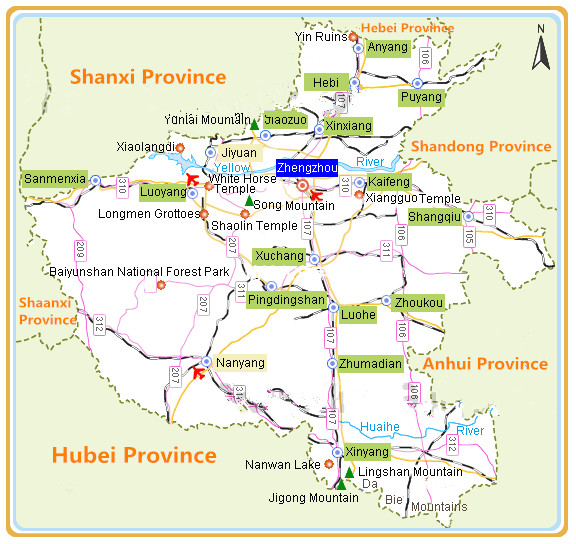Skype: neodalle-travel
Tel: +86 135 7447 2266
E-mail: sales@visitaroundchina.com
 Henan , Yu 豫(yù) for short, is a province located in the Northern Central Area of China. The name Henan (河南) means "South of the River", a reference to the province's location —— South of the Yellow River. It shares its borders with six other provinces, Shandong to the northeast, Hebei to the north, Shanxi to the northwest, Shaanxi to the west, Hubei to the south, and Anhui to the east. The eastern portion is flat and part of the North China Plain, one of the most densely populated areas on Earth. Indeed Henan is the most populous province in China, with almost 100 million people. The mountainous west and southwest is more remote with vast expanses of forest.The Yellow River ,mother river of the Chinese nation, runs through the province of Henan.
Henan , Yu 豫(yù) for short, is a province located in the Northern Central Area of China. The name Henan (河南) means "South of the River", a reference to the province's location —— South of the Yellow River. It shares its borders with six other provinces, Shandong to the northeast, Hebei to the north, Shanxi to the northwest, Shaanxi to the west, Hubei to the south, and Anhui to the east. The eastern portion is flat and part of the North China Plain, one of the most densely populated areas on Earth. Indeed Henan is the most populous province in China, with almost 100 million people. The mountainous west and southwest is more remote with vast expanses of forest.The Yellow River ,mother river of the Chinese nation, runs through the province of Henan.Facts of Henan
Chinese Name: 河南省(hë nán shêng)
Add: in the Northern Central Area of China
Area: 167,000 km2
Population: 10,906,000 (2018)
Nationalities: Han, Hui, Manchu, Mongolian
Capital: Zhengzhou
Administrative: there are 18 cities under the Henan Province Government. They are Zhengzhou,Luoyang,Kaifeng,Xinxiang, Nanyang,Jiaozuo,Zhumadian,Puyang,Anyang, Sanmenxia Xuchang,Zhoukou
Henan Tourism
Henan's famous historical and cultural cities include Zhengzhou, Kaifeng, Luoyang, Anyang, Nanyang, Shangqiu, Sanmenxia, Pingdingshan, Xinxiang and others. Traveling Henan means enjoying the beautiful landscape and the historic relics and ruins. It also means seeking the Chinese roots and rediscovering the soul of the Chinese nation.
Education of Henan
Since its imperial days Kaifeng has remained the cultural and educational centre of Henan, although it has come to share that role with Zhengzhou. The first impact of Western learning came, as in the rest of China, through the primary and middle schools of Christian missions. Little real progress was made in the turbulent years between 1911 and 1949, and the vast mass of the people remained illiterate. Successful efforts were made by the government in the first years after 1949 to overcome illiteracy, and a real attempt at universal primary education was launched. Education is now based on six years of primary schooling and six years of secondary schooling. Henan has more than 50 institutes of higher learning, including Henan University (1912) in Kaifeng and Zhengzhou University (1956).
Health and welfare of Henan
Modern Western medicine was introduced by Christian missions but made little impact on the vast area of Henan. On attaining power in 1949, the new national government concentrated attention on public hygiene and preventive medicine. A doctor’s training was cut from six to three years, and teams were dispersed throughout the province to teach hygiene, vaccinate, inoculate, and advise. Although a doctor’s training has now reverted to six years, emphasis has remained on midwives and health workers. With the great development of coal mining in Henan, attention has been focused on silicosis prevention, which is being achieved mainly by improving working conditions. Kala-azar, the debilitating disease carried by sand flies, is also receiving special attention. As elsewhere in the country, traditional Chinese medicine has gained status.
 Ask Questions ?
Ask Questions ?